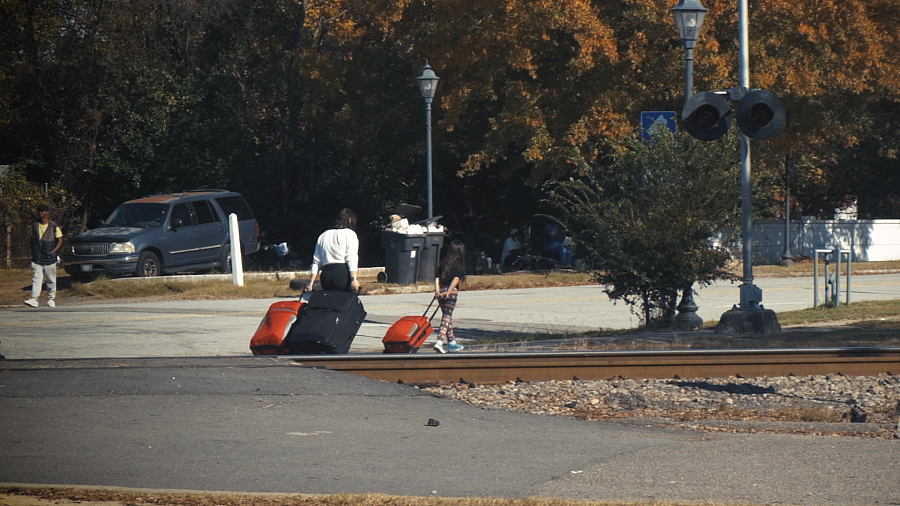The pandemic’s homeless students have been left to languish in Georgia

(Photo via Liz Owens)
AUGUSTA, Ga. — It’s hard for drivers not to notice the sea of faces walking out of the Salvation Army’s homeless shelter and along Telfair Street every morning. It’s even more difficult to ignore the school- aged children pulling small suitcases behind them.
It’s a visual I see nearly every morning while I wait in the car line to drop my daughter off at school. Why are the children stepping out of the shelter not stepping onto a school bus? Why are they spending their days sitting in the public library instead of sitting in a classroom?
Richmond County School District is a failure. It’s not an opinion. It’s a fact. The district scored an “F” in the Georgia Department of Education’s College and Career Ready Performance Index (CCRPI) during the last assessment. The failing grade came before the pandemic.
Students here already faced many challenges before the pandemic arrived. Only a third of third graders and half of eighth graders are reading at their grade level. A quarter never graduate high school. Nearly half of the 32,000 students are economically disadvantaged. Most are Black.
The pandemic hit students like an earthquake. Schools closed. Poor students without WiFi or devices struggled to learn from home while their parents were forced to choose between working their low-paying job or staying at home with their children. Others lost their jobs. Housing skyrocketed and affordable housing dwindled to near extinction.
More than 900 students returned to the classroom the following school year without a home. The district did not publicly share the surge in homelessness among its students. City leaders didn’t see the fallout from the pandemic until after the 2020-21 school year ended. Even today, they do not know its full impact.
In a conference room turned war room, deputies, marshals, city, and nonprofit workers gathered like generals at a mission debriefing. “We know it’s broken. It’s broken to pieces. Nothing is working right now,” exclaimed Shawn Rhodes with the Richmond County Marshals Office.
City leaders created a homeless task force to pinpoint systemic gaps after seeing a rise in homelessness over the summer. They’ve identified 38 encampments and surveyed nearly 200 homeless individuals in just five days. What they don’t know is hidden in the Richmond County School District’s database.
I requested the data, part of my reporting project under the auspices of the 2020 Data Fellowship. The majority of the 900 homeless students last school year were in elementary school. I found one out of every 10 students at Lamar-Milledge Elementary were identified as homeless last school year. The school is located a mile and half from the city’s only family homeless shelter.
An increase in homelessness among students living in poor areas of town during the pandemic is about as expected as exposure to the highly contagious omicron variant. What is unexpected is the drastic drop in the number of homeless students despite the housing crisis and expiration of the eviction moratorium. The number of known or documented homeless students dropped from 920 to 273 this school year. Even more surprising? More than 900 students this current school year are classified as “missing” by the school district.
The district spokesperson told me they do not roll over the names of homeless students from the previous school year. Each homeless student must be identified or reidentified each school year. Unidentified students are not protected under the McKinney-Vento Homeless Education Act. The Act requires districts to eliminate barriers for homeless students such as transportation and enrollment. The district also receives funding to address such barriers and to conduct outreach.
The data on missing students is also concerning. The number of missing high school students shot up 75% this year. Nearly half of the 900 missing students district wide are missing from the high schools. The district’s overall graduation rate dipped during the year of the pandemic. One can’t help but wonder if the dip will turn into a plunge this spring.
The district’s spokesperson is slow to respond to inquiries about the process used to identify homeless students and locate missing students. However, they are scrambling to make changes. I learned through the homeless task force that the district has put in place an agreement with local law enforcement the week following my third request for an interview.
The agreement requires law enforcement to contact the Richmond County Board of Education when a child’s parents are involved in a law enforcement event, such as in the case of a woman named Crystal Clark. Deputies were called when Clark was unable to pay for a taxi ride in December. The homeless task force told me the mother of four school-aged children had been relying on a taxi to get them from the shelter to school every day.
Liz Owens is the senior investigative reporter at WRDW/WAGT in Augusta, Georgia.

